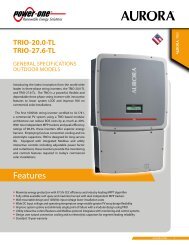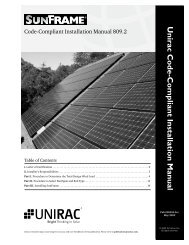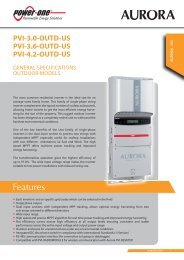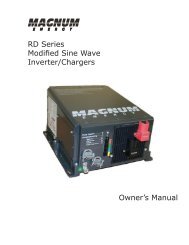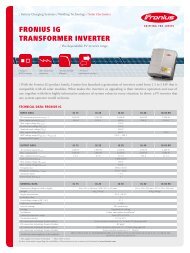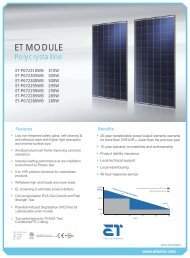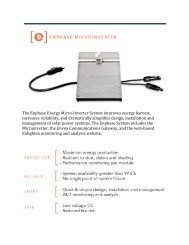MS Series Owner's Manual - Magnum Energy
MS Series Owner's Manual - Magnum Energy
MS Series Owner's Manual - Magnum Energy
Create successful ePaper yourself
Turn your PDF publications into a flip-book with our unique Google optimized e-Paper software.
Operation<br />
3.6 Protection Circuitry Operation<br />
The inverter is protected against fault conditions and in normal usage it will be rare to see any.<br />
However, if a condition occurs that is outside the inverter’s normal operating parameters, then<br />
it will shut down and attempt to protect itself, the battery bank, and your AC loads. If there is a<br />
condition that causes the inverter to shutdown, it may be one of the following conditions [also refer<br />
to the Troubleshooting section (Section 4.3) to help diagnose and clear the fault condition].<br />
• Low Battery - The inverter will shut off whenever the battery voltage falls to the LBCO<br />
(Low Battery Cut Out) level to protect the batteries from being over-discharged. After the<br />
inverter has reached the LBCO level and turned off, the inverter will automatically restart<br />
after one of the following conditions:<br />
1. AC Power is applied and the inverter begins operating as a battery charger.<br />
2. Battery voltage rises to the LBCI (Low Battery Cut In) level.<br />
The inverter’s status LED turns off when a low battery fault condition occurs. Refer to Table<br />
3-1 to determine the LBCO and LBCI levels for your inverter model.<br />
• High Battery - In the event the battery voltage approaches the HBCO (High Battery<br />
Cut Out) level, the inverter will automatically shut down to prevent the inverter from<br />
supplying unregulated AC output voltage. The inverter’s status LED turns off when a high<br />
battery fault condition occurs. The inverter will automatically restart when the battery falls<br />
to the HBCI (High Battery Cut In) level. Refer to Table 3-1 to determine the HBCO and<br />
HBCI levels for your inverter model.<br />
Info: High battery voltage may be caused by excessive or unregulated voltage<br />
from the solar panels or other external charging sources.<br />
• Overload - During inverter and standby operation, the inverter monitors the DC and AC<br />
current levels. In the event of a short-circuit or an overload condition for more than a few<br />
seconds, the inverter will shut down. To start operating after this fault, the inverter would<br />
need to be restarted (turned back on) after the inverter’s AC loads are reduced/removed.<br />
• Over-temperature - If internal power components begin to exceed their safe operating<br />
temperature level, the inverter will shut down to protect itself from damage. The inverter’s<br />
status LED turns OFF to indicate the over-temperature fault condition. The inverter will<br />
automatically restart after the units cools down.<br />
• Internal Fault - The inverter continually monitors several internal components and the<br />
processor communications. If an condition occurs that does not allow proper internal<br />
operation, the inverter will shutdown to protect itself and the connected loads. The inverter<br />
will need to be reset to start operating, refer to section 4.4 for information on resetting the<br />
inverter.<br />
Table 3-1, Inverter Battery Turn On/Off Levels<br />
Inverter battery turn<br />
Inverter Model<br />
ON/OFF Levels <strong>MS</strong>2000/<strong>MS</strong>2012 <strong>MS</strong>2812 <strong>MS</strong>4024<br />
HBCO >16.8 VDC >16.8 VDC >33.8 VDC<br />
HBCI 16.5 VDC 16.5 VDC 33.2 VDC<br />
LBCI 12.5 VDC 12.5 VDC 25.0 VDC<br />
LBCO*<br />
(1 minute delay)<br />
10.0 VDC<br />
(9.0 - 12.2 VDC)<br />
10.0 VDC<br />
(9.0 - 12.2 VDC)<br />
20.0 VDC<br />
(18.0 - 24.4 VDC)<br />
LBCO (immediate) 8.5 VDC 8.5 VDC 17.0 VDC<br />
*adjustable with remote control<br />
© 2009 <strong>Magnum</strong> <strong>Energy</strong> Inc.<br />
Page 43




